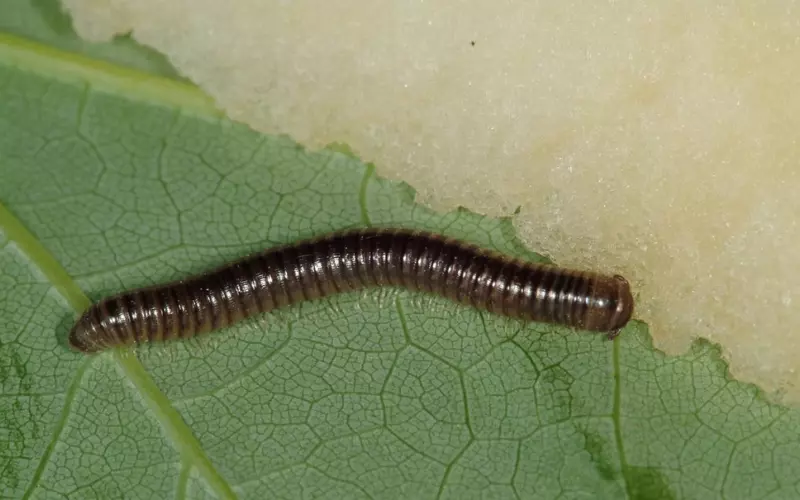Millipedes, also known as thousand-leggers, are fascinating creatures. They belong to a group of animals called arthropods, which means “jointed legs”. Millipedes are found in various parts of the world, including forests, gardens, and even in people’s homes. In this blog post, we will explore the history, facts, size, habitat, and classification of millipedes.
Millipedes have a long history that dates back to more than 400 million years ago. Fossil records show that these intriguing animals have been around for a remarkably long time. They have evolved and adapted to survive in different environments. Despite their name, millipedes don’t really have a thousand legs. Most species have around 30 to 400 legs, which they use for movement and defence.
These gentle creatures have an important role in our ecosystem. They primarily feed on decaying leaves and dead plant material, playing a vital role in breaking down organic matter and enriching the soil. Millipedes usually prefer damp and dark habitats, such as under logs, rocks, or in the soil. They are found in almost every continent except for Antarctica.
Millipedes are part of the arthropod family. They are classified under the subphylum Myriapoda, which means “many legs”. There are over 10,000 known species of millipedes, each unique in appearance and behaviour. With their elongated bodies and numerous legs, millipedes can be easily identified. So, let’s dive deeper into the world of these fascinating creatures and discover more about their history, intriguing facts, sizes, habitats, and classifications in the upcoming sections of this blog post.
History of Millipede
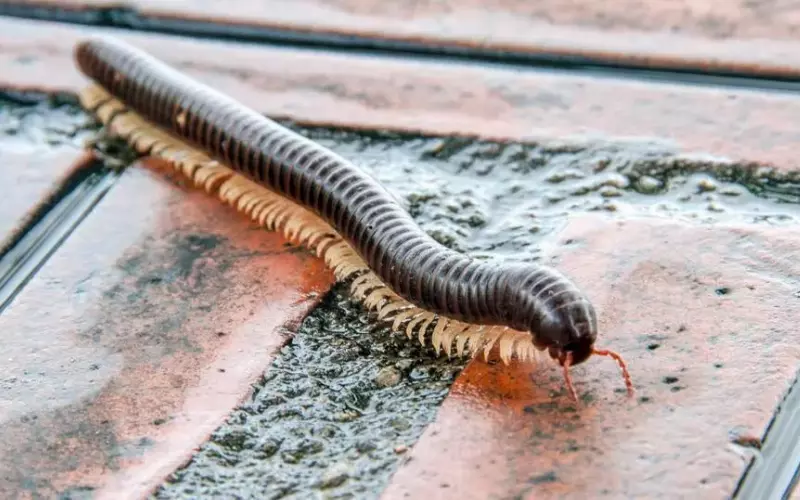
Millipedes are fascinating animals that have been on Earth for a very long time. They belong to a group of invertebrates called arthropods, which also include insects, spiders, and crustaceans. The history of millipedes dates back to over 400 million years ago during a time called the Silurian period.
During the Silurian period, millipedes evolved from a common ancestor that they shared with centipedes. These ancestors were the earliest land-dwelling arthropods and played an important role in shaping Earth’s ecosystems. As millipedes adapted to life on land, they developed a unique feature – their many legs. Contrary to their name, millipedes don’t actually have a thousand legs, but they do have a lot! Most millipedes have between 30 and 400 legs, with each segment of their body having two pairs.
Millipedes have continued to thrive and diversify over millions of years. Today, there are over 12,000 known species of millipedes worldwide, each with its own unique characteristics and appearance. They can be found in various habitats, such as forests, deserts, and even caves. Millipedes have an important role in the ecosystem as they help with the decomposition of organic matter and contribute to soil health. Despite their many legs, millipedes are not known for their speed. They move slowly and rely on their tough exoskeleton and chemical defences to protect themselves from predators.
Millipedes have a long and fascinating history that spans over millions of years. They evolved from early land-dwelling arthropods during the Silurian period and developed their distinctive feature of many legs. Today, millipedes play an important role in maintaining the balance of ecosystems worldwide, showcasing the wonders of nature’s diversity.
Importance of Millipede
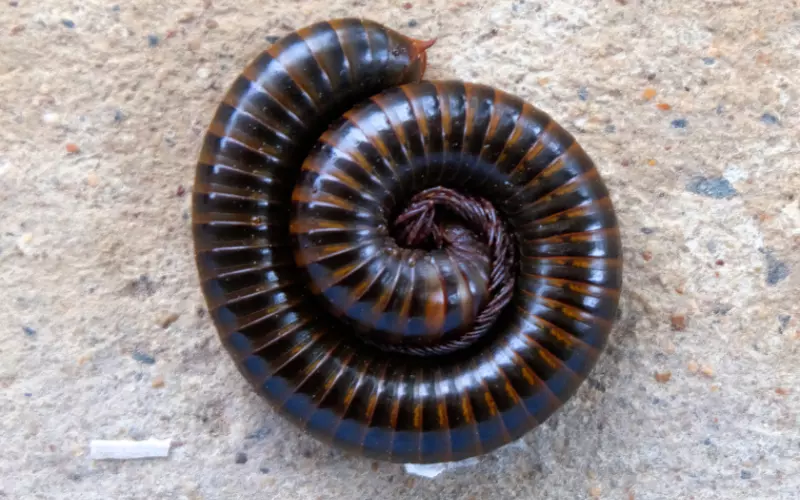
Millipedes are small animals that play an important role in the ecosystem. They might look creepy with their many legs, but they actually help keep the environment clean and healthy. These fascinating creatures are decomposers, meaning they eat dead plants and animals. By doing so, they break down these materials into smaller pieces, helping them to decompose faster. This process releases nutrients back into the soil, which is vital for the growth of new plants. So, millipedes are like nature’s recyclers, ensuring that nutrients are recycled and not wasted.
Another important role of millipedes is that they provide food for other animals. Many birds, small mammals, amphibians, and reptiles feed on millipedes. Without millipedes, these animals might struggle to find enough food to survive. This is why it’s crucial to protect millipedes and maintain their population in the wild.
Lastly, millipedes also serve as indicators of a healthy environment. Their presence in an area shows that the habitat is suitable for them to live in. If millipedes disappear from an area, it could be a sign that something is wrong with the ecosystem. This can help scientists and researchers identify and address any problems before they become more serious.
Millipedes are important animals that help break down dead plants and animals, provide food for other animals, and act as indicators of environmental health. Their role in maintaining a balanced ecosystem cannot be underestimated. So, let’s appreciate and protect these amazing creatures for a healthier and more sustainable planet.
Amazing Facts About Millipede
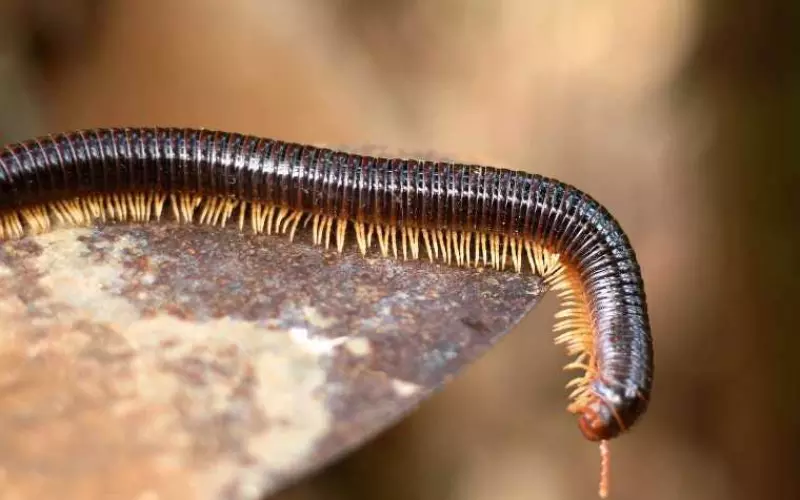
1. Millipedes are arthropods, which means they have an exoskeleton and jointed legs.
2. Despite their name, millipedes do not have a thousand legs. They usually have between 30 and 400 legs.
3. These creatures come in a variety of sizes, ranging from about 0.08 inches to over 11 inches long.
4. Millipedes are typically found in moist environments like forests, gardens, and soil.
5. They play an important role in the ecosystem by decomposing dead plants and leaves, helping to break down organic matter.
6. Millipedes have a cylindrical body shape and are usually brown or black.
7. Some species of millipedes can release a strong-smelling liquid as a defence mechanism to deter predators.
8. Despite their numerous legs, millipedes move relatively slowly compared to other arthropods.
9. They have a segmented body, with each segment bearing its pair of legs.
10. Millipedes have a pair of antennae on their head, which they use to sense their surroundings.
11. These animals are primarily herbivorous, feeding on decaying plant matter and sometimes live plants.
12. Millipedes moult throughout their lifetime, shedding their exoskeleton to grow larger.
13. Some millipede species have brightly coloured patterns or patterns that mimic toxic or dangerous animals as a form of defence.
14. Millipedes are not harmful to humans, as they do not bite, sting, or transmit diseases.
15. Although millipedes are related to centipedes, they are generally harmless and less aggressive than their counterparts.
Can we keep Millipede as our Pet?
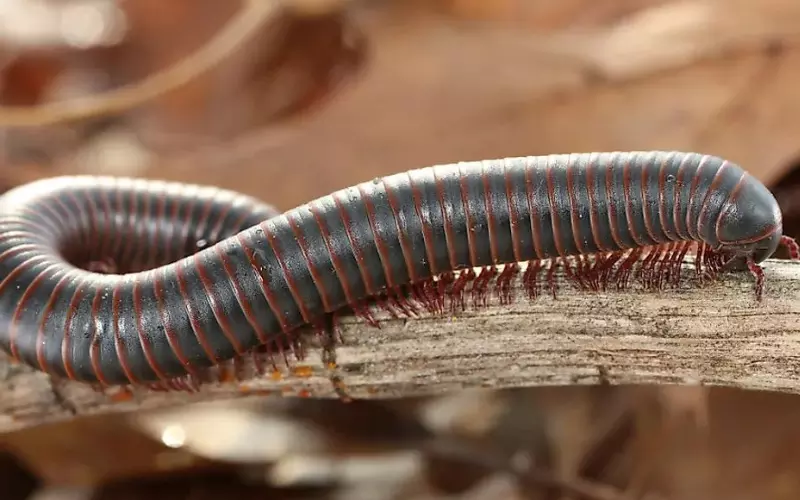
Millipedes, which are small arthropods with many legs, are not usually kept as pets by people. While millipedes may seem interesting and unique, they have specific needs that can be challenging to meet in a home environment. Therefore, it is generally not recommended to keep a millipede as a pet.
Firstly, millipedes require a specialized habitat in order to thrive. They need a tank with the right temperature and moisture levels, as well as a substrate that mimics their natural environment. It can be difficult to create and maintain these ideal conditions, which could result in health problems for the millipede. Additionally, millipedes primarily eat decaying vegetation, so it can be challenging to provide them with a suitable diet in captivity.
Secondly, millipedes have specific behaviours that may not be enjoyable for pet owners. They often secrete a defensive fluid that can stain surfaces and cause skin irritation. This secretion is unpleasant and can be difficult to remove. Furthermore, millipedes are not known for their interactive nature, as they typically spend most of their time burrowing and hiding. This means that they may not provide the companionship and entertainment that many people seek in a pet.
Due to their specific habitat requirements and defensive behaviours, it is not advisable to keep millipedes as pets. They have unique needs that can be challenging to fulfil in a home environment, and they may not offer the same level of companionship as other, more interactive pets. It is important to research and consider the welfare of any animal before deciding to keep it as a pet.
Size of Millipede

Millipedes are intriguing creatures that live in various parts of the world. These animals belong to the arthropod family and are known for their numerous legs. As their name suggests, millipedes have many legs, but it might surprise you to learn that they don’t actually have a thousand legs, as some people may think. In fact, most millipedes have around 400 legs, but this can vary depending on the species.
Despite their name, millipedes come in different shapes and sizes. On average, they can range from 0.04 inches to 12 inches long. However, some millipedes can grow even longer, with the largest species called the giant African millipede, measuring up to 15 inches in length. To put it in perspective, that’s about the length of a ruler! However, it is important to note that millipede sizes can differ greatly, depending on the specific species and their habitat.
Millipedes have a long and cylindrical body, which is composed of segments. Each segment possesses pairs of legs. The precise number of legs per segment may vary, but the general rule is that millipedes have two pairs of legs per segment. This distinctive feature allows them to move in a unique wave-like motion. Their size and numerous legs give them a fascinating appearance and make them easily distinguishable from other animals.
In conclusion, millipedes are arthropods with a significant number of legs, but not as many as their name might suggest. They come in various sizes, with the average millipede being around 0.04 to 12 inches in length. Depending on the species, they can grow even longer, extending up to 15 inches. The multitude of legs and their wave-like motion make millipedes intriguing creatures to observe and learn about.
Habitat of Millipede

A millipede, an interesting creature with many legs, lives in a special place called its habitat. The habitat of a millipede can vary depending on the species. Millipedes can be found all over the world, except in places with extremely cold temperatures, like the polar regions. They are commonly found in forests, gardens, and even in our homes!
In forests, millipedes can be seen crawling on the forest floor. They like to live in areas with lots of fallen leaves and dead plant material. These little creatures love to hide under rocks, logs, and decaying tree trunks. They prefer moist and dark places, as they help keep their body hydrated. In gardens, millipedes can be found in the soil or underneath potted plants. They help to break down decaying organic matter, like dead leaves and plant debris, which helps keep the soil healthy.
Sometimes, millipedes may find their way into our homes. You might see them in damp basements, bathrooms, or dark corners. They can accidentally enter our houses through cracks or open doors. Millipedes might seem creepy to some people, but they are harmless. They are just searching for shelter and food, so it’s best to gently remove them and release them back into their natural habitat.
The habitat of a millipede can be in forests, gardens, and even our homes. They enjoy moist and dark places where they can find food and stay hydrated. While they may look strange, millipedes are harmless creatures that play an important role in the ecosystem by helping to decompose dead plant material.
Classification of Millipede
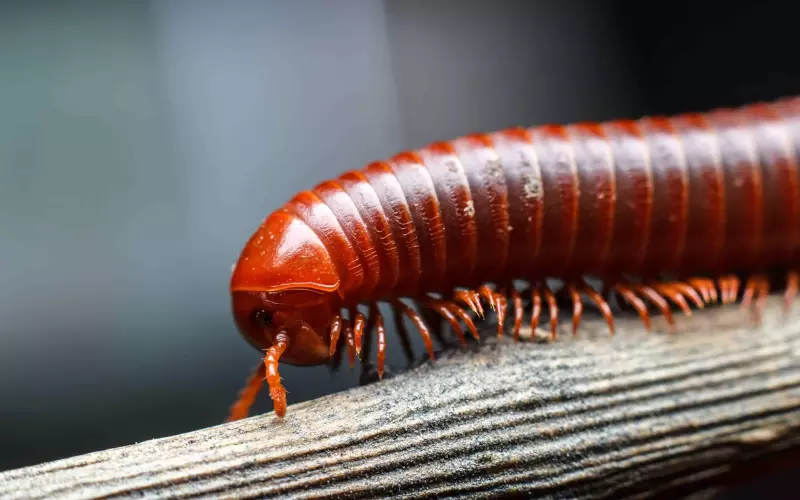
Millipedes are fascinating insects that belong to the class Diplopoda. They are part of the larger group called arthropods, which also include insects, spiders, and crustaceans. Millipedes are known for their numerous legs, with the name “millipede” meaning “thousand feet.” However, despite their name, most millipede species don’t actually have a thousand legs.
Millipedes are classified under the phylum Arthropoda, which means they have jointed legs and a hard exoskeleton. This exoskeleton protects their body and helps them maintain moisture, which is essential for their survival. Millipedes also have a unique feature called the “diplosegment,” which means that each body segment is divided into two parts, giving them the appearance of having two pairs of legs per segment.
Within the class Diplopoda, millipedes are further divided into several orders. One of the most common orders is the Polydesmida, which includes millipedes with cylindrical bodies and short legs. Another order is the Julida, which includes millipedes with long, cylindrical bodies and longer legs. Each order has its distinct characteristics, such as colour, size, and habitat preferences.
Millipedes are a type of arthropod belonging to the class Diplopoda. They have jointed legs and a hard exoskeleton which protects their body. Millipedes are further classified into various orders based on their physical features. Despite having the name “thousand feet,” most millipede species do not have a thousand legs. They are intriguing creatures found in various habitats, and their classification helps scientists better understand their diversity and behaviour.
Different Types of Millipede
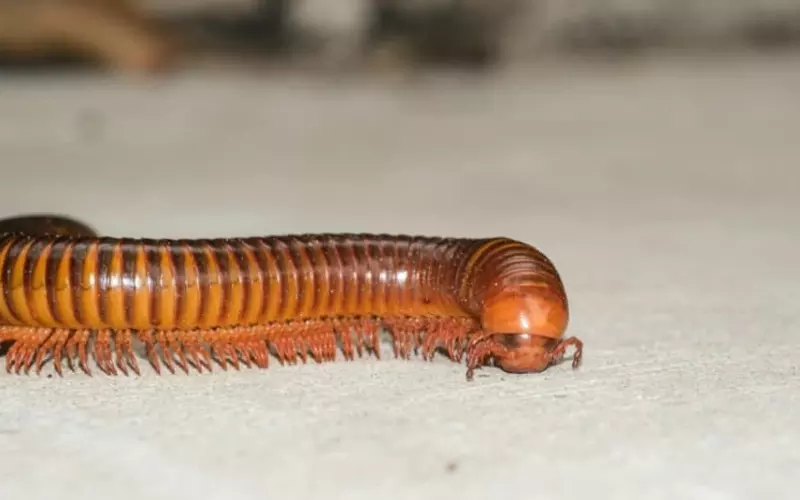
1. African Giant Millipede: This type of millipede is one of the largest in the world, measuring up to 38 centimetres long. It is known for its unique colouration and is often kept as a pet due to its gentle nature.
2. Yellow-Banded Millipede: As its name suggests, this millipede has distinctive yellow bands along its black body. It feeds on decaying plant matter and can release a foul-smelling liquid when threatened as a defence mechanism.
3. Fire Millipede: Also known as the cherry millipede, this species has a bright red or orange colouration, warning predators that it is toxic. It releases a toxic fluid when threatened, irritating if it comes into contact with human skin.
4. Flat-Backed Millipede: With a flattened body shape, this millipede can live in various habitats, including rainforests and deserts. It curls up into a tight spiral when threatened, protecting its soft underside.
5. Florida Ivory Millipede: Found mainly in Florida, this millipede has a pale yellow or white colour, hence its name. It prefers moist habitats such as rotting logs and leaf litter and plays a role in decomposing organic matter in the ecosystem.
6. Giant Pill Millipede: The giant pill millipede is unique as it rolls itself into a tight ball when threatened, resembling a pill. This behaviour protects its legs and other vulnerable body parts. It has a dark brown colour and is found in forests across Europe.
7. North American Millipede: This species of millipede is dark brown or black and has a rough texture on its body. It is commonly found in North America and consumes decaying plant matter. When threatened, it can produce a foul-smelling fluid to deter predators.
8. Glow-in-the-Dark Millipede: Found in certain areas of California, this millipede has bioluminescent properties. When disturbed, it gives off a greenish glow that helps it to both deter predators and attract mates.
9. Gold Millipede: This millipede species, native to Southeast Asia, has a striking gold colouration. It feeds primarily on decaying leaves and can often be found in tropical rainforests. Its bright colour serves as a warning to potential predators.
10. Chocolate Millipede: Also known as the rusty millipede, this species has a dark brown colour that resembles chocolate. It is found in various habitats, including woodlands and gardens, and plays a crucial role in breaking down organic matter, contributing to the nutrient cycle of the ecosystem.
Geographical Presence of Millipede

Millipedes are found in various regions around the world. They can be found in forests, deserts, grasslands, and even in some urban areas. These fascinating creatures thrive in moist environments, such as under logs, leaves, and rocks. They are often encountered in countries like the United States, Canada, Australia, and many parts of Europe and Asia.
However, there are certain regions where millipedes are not found. They are not commonly found in extremely cold regions like the Arctic and Antarctica, where the environment is too harsh for them to survive. Similarly, millipedes may also be scarce in dry regions like the Sahara Desert, where there is a lack of the moisture they need for survival.
Millipedes are generally quite adaptable, which allows them to inhabit a variety of regions. They play an important role in ecosystems as decomposers, helping to break down dead plant material and recycle nutrients back into the soil. However, they prefer areas with ample organic matter and moisture, as these provide them with food sources and suitable habitats.
Millipedes can be found in many regions around the world, including forests, deserts, grasslands, and urban areas. They thrive in moist environments and are commonly encountered in countries like the United States, Canada, Australia, Europe, and Asia. However, they are not typically found in extremely cold regions like the Arctic and Antarctica or dry regions like the Sahara Desert. Their adaptability allows them to fulfil important ecological roles in the areas they inhabit.
Diet of Millipede
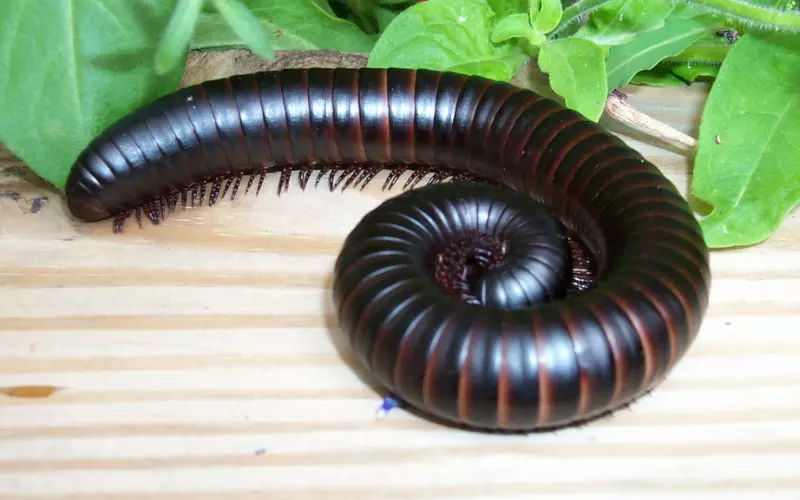
Millipedes have a unique diet that consists mainly of decaying plants and organic matter. They are detritivores, which means they feed on dead plant material like leaves and bark. Millipedes also consume fungi and small insects that are found in the soil. Their diet helps in the decomposition process, which is essential for the ecosystem.
Millipedes have a special way of eating. They use their mouthparts, called mandibles, to chew and break down the plant matter. These mouthparts are strong and designed specifically for grinding and shredding. Millipedes also have a feature called the “mouth cone” that helps them push food into their mouths. They typically eat by taking small bites and swallowing the food quickly.
In addition to their diet, millipedes also play an important role in the environment. Their feeding habits help to break down dead plant material into smaller pieces, which makes it easier for bacteria and fungi to decompose them further. This process releases nutrients back into the soil, benefiting other organisms and supporting plant growth. Therefore, millipedes are not only essential for the ecosystem but also help in maintaining a healthy balance in nature.
Locomotion of Millipede

Millipedes are incredible creatures that move uniquely! When they want to get from one place to another, they use their many legs to help them walk. These legs are arranged in pairs along the sides of their bodies.
To move forward, millipedes coordinate their legs in a wave-like motion. Starting from the front, the legs on one side move forward, followed by the legs on the other side. This back-and-forth movement creates a wave that travels along their body, propelling them forward. It looks a bit like a caterpillar crawling, but instead of just a few pairs of legs, millipedes have lots of them!
In addition to walking, millipedes can also curl up if they feel threatened. They use their legs to tuck their bodies into a tight spiral shape, like a little ball. This helps protect their soft undersides from potential harm. Once they feel safe again, they uncurl and resume their slow and steady locomotion. It’s fascinating how millipedes use all their legs to move around and keep themselves safe!
Social and Sexual Behaviour of Millipede

Millipedes, those little creatures with numerous legs, exhibit interesting social and sexual behaviour. These fascinating insects often live together in groups, forming large colonies. Within these colonies, millipedes engage in various activities like feeding, exploring, and even communicating with one another.
The social behaviour of millipedes is primarily focused on cooperation. They work together to find food sources and protect themselves from potential threats. When one millipede discovers food, it releases a pheromone, a special chemical scent, in the air to signal others in the group. This allows the entire colony to benefit from the food source. Similarly, if a millipede senses danger, it alerts the others by producing a different pheromone so they can all defend themselves.
Now, let’s talk about the sexual behaviour of millipedes. They have a peculiar way of mating called “mating trains.” In this process, several males form a line behind a female, each one attaching himself to her body using special hooks. This train-like structure ensures that only one male fertilizes the female’s eggs, even though many others are trying to mate with her. This activity ensures the survival of their species by preventing too many males from competing all at once.
Millipedes are social creatures that work together to find food and stay safe. Their social behaviour is based on communication through pheromones. When it comes to reproduction, millipedes form mating trains, where multiple males line up behind a female, each trying to be the one to fertilize her eggs. These unique characteristics of millipedes make them truly fascinating animals to study.
Reproduction and Lifecycle of Millipede
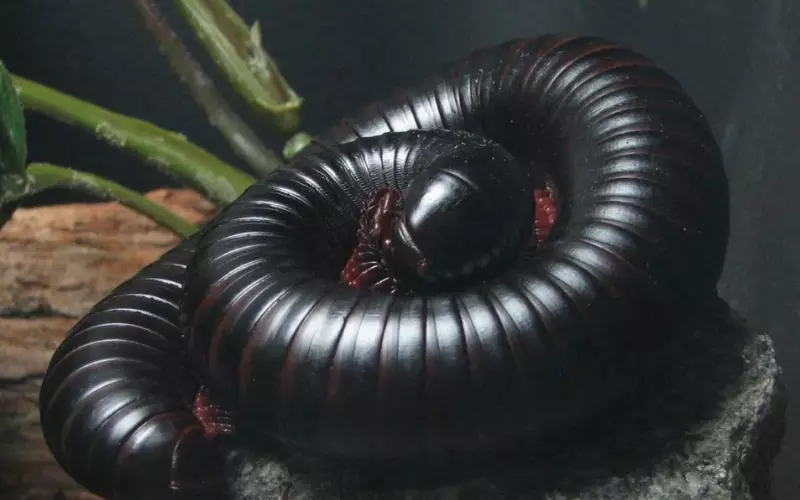
Millipedes are fascinating creatures that have a unique life cycle and reproduction process. Let’s explore how these little animals grow and multiply.
The life cycle of a millipede begins with the hatching of the eggs laid by the female millipede. These eggs are typically small and round, and they are usually laid in damp soil or decaying vegetation to provide a suitable environment for the young millipedes to develop. After a period of incubation, the eggs hatch and tiny millipedes emerge. These baby millipedes, also known as nymphs, are very different from their parents. They have a smaller number of legs and are generally lighter in colour.
As the baby millipedes continue to grow, they shed their exoskeleton in a process called moulting. Moulting is necessary for the millipede to grow larger and develop more segments and legs. Each time a millipede moults, it adds more segments and legs until it reaches its adult size. This process can take months or even years, depending on the species of millipede.
Once a millipede has reached adulthood, it is ready to reproduce. Millipedes have separate sexes, with males and females mating to produce offspring. The male millipede will deposit sperm on a special structure called a gonopod and transfer it to the female during mating. The female then lays fertilized eggs, starting the life cycle all over again.
Millipedes go through a fascinating life cycle that includes hatching from eggs, moulting to grow, and eventually reproducing to start the cycle again. From tiny nymphs to full-grown adults, these creatures provide a captivating glimpse into the wonders of nature.
Threats to Millipede
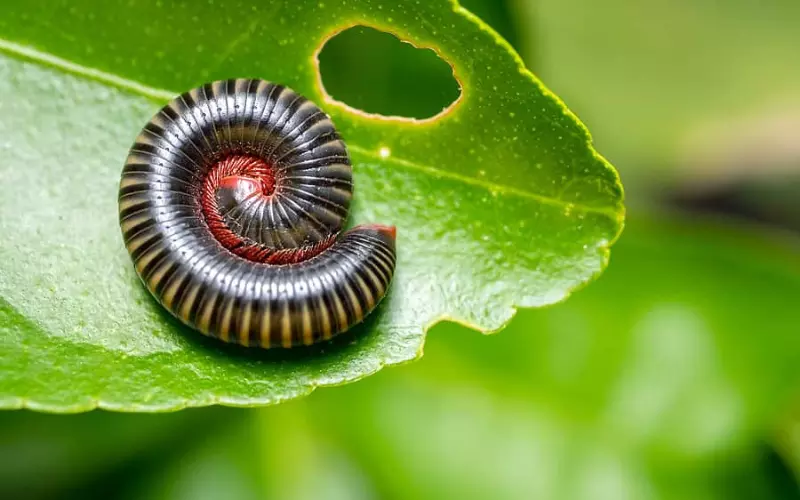
Millipedes are small animals that belong to the arthropod group. They have many legs, often more than a hundred, and are commonly found in forests, gardens, and other damp places. Although millipedes may seem harmless, they face several threats in their natural environment.
One of the main threats to millipedes is habitat loss. When humans clear forests or destroy natural habitats for various purposes like agriculture or infrastructure development, millipedes lose their homes. Without suitable places to live, they struggle to find enough food and become more vulnerable to other challenges.
Another threat to millipedes is pollution. When harmful chemicals are released into the air or water, they can directly affect millipedes and the ecosystem they are a part of. Polluted habitats negatively impact their health and ability to reproduce, leading to a decline in their population.
Lastly, millipedes are also at risk from predators. Birds, lizards, and small mammals consider millipedes as a food source. When these predators increase in number, millipedes may be hunted more frequently, which in turn affects their population levels.
To protect millipedes, it is crucial to conserve their natural habitats. Efforts should be made to prevent deforestation and develop sustainable ways of using land without harming their living spaces. Additionally, reducing pollution through proper waste disposal and the use of eco-friendly practices is essential to safeguard the millipede population. Creating awareness about the importance of millipedes and their role in the ecosystem can also help in their protection.
Conclusion
Overall, the millipede is a fascinating creature with an interesting history, unique facts, and specific characteristics. This animal, known as a millipede, is part of a larger group of creatures called arthropods. Just like their name suggests, millipedes are known for having many legs. In fact, they can have anywhere from 30 to 400 legs, depending on the species of millipede.
Millipedes have been around for a very long time. Fossil evidence suggests that these animals have been on Earth for over 400 million years! They have adapted to various habitats, ranging from tropical rainforests to deserts. Millipedes are often found in moist environments like under rocks, leaves, or even underground. These creatures are decomposers, meaning they feed on dead plants and organic matter, playing an important role in maintaining the ecosystem.
In terms of size, millipedes can vary greatly. Some species are as small as a few millimetres, while others can reach lengths of more than 30 centimetres. Despite their numerous legs, millipedes are harmless to humans. They have a hard exoskeleton that serves as protection, and some species are even capable of producing toxic chemicals to deter predators. Overall, the millipede is a fascinating creature that contributes to the biodiversity of our planet and plays a crucial role in nature.
Frequently Asked Questions about Millipede (FAQ’s)
What is a millipede?
A millipede is a type of arthropod that is known for having an elongated body, multiple segments, and numerous pairs of legs.
How many legs does a millipede have?
Despite its name, a millipede does not have 1,000 legs. The number of legs can vary depending on the species, but most have between 30 and 400 legs.
Are millipedes poisonous?
Most millipedes are not poisonous, but they can secrete a foul-smelling liquid or produce irritating substances that can cause mild skin irritation in humans.
What do millipedes eat?
Millipedes are detritivores, which means they primarily feed on decaying organic matter such as dead leaves, plant debris, and compost.
Where do millipedes live?
Millipedes are found in various habitats around the world, including forests, grasslands, deserts, and even caves. They prefer moist environments.
How long do millipedes live?
The lifespan of millipedes varies depending on the species, but most live for about 2 to 7 years.
Do millipedes bite humans?
While it is rare, some millipede species can bite humans. However, their bites are generally harmless and similar to a mild insect sting.
Can millipedes be kept as pets?
Yes, some people keep millipedes as pets. They can be housed in terrariums with appropriate substrate, humidity, and ventilation.
How do millipedes defend themselves?
Millipedes have various defence mechanisms, including curling up into a tight spiral, secreting toxic substances, and exuding a foul-smelling liquid.
Are millipedes beneficial to the environment?
Yes, millipedes play a crucial role in the ecosystem as decomposers. By feeding on dead organic matter, they help break it down and recycle nutrients into the soil.
Can millipedes swim?
Most millipedes are not capable of swimming, as they lack the necessary adaptations. However, some species that inhabit wetlands or bodies of water can float and move through the water.
Can millipedes regenerate lost legs?
Yes, millipedes have the remarkable ability to regenerate lost legs during their moulting process, allowing them to recover from injuries.
Do millipedes have eyes?
Yes, most millipedes have simple eyes called ocelli, which can detect light and shadows but do not provide detailed vision.
Are millipedes and centipedes the same?
No, millipedes and centipedes are two distinct groups of arthropods. While both have many legs, millipedes have two pairs of legs per body segment, while centipedes have one pair.
Can millipedes be harmful to plants?
While millipedes primarily feed on decaying plant matter, some species can damage living plants by chewing on stems, roots, or foliage.

Hi there! I’m Morgan Gutierrez, and I love animals! I work as a Seasonal Animal Care Specialist at Brookfield Zoo and also teach people about animals, which is super fun. I studied at Valparaiso University in Lockport, Illinois, where I learned even more about these amazing creatures.
I’m not just about taking care of animals; I write articles about them, too! I explore and share many interesting animal stories, from cute kittens to giant elephants.
In the past, I’ve worked with veterinarians, helped with research, and even been an Animal Ambassador, bringing animals closer to people. Animals are my passion, and I enjoy helping others learn about them. So, if you ever want to know about animals, feel free to ask. I’ll explain it in a way that’s easy to understand, just like talking to a friend!

